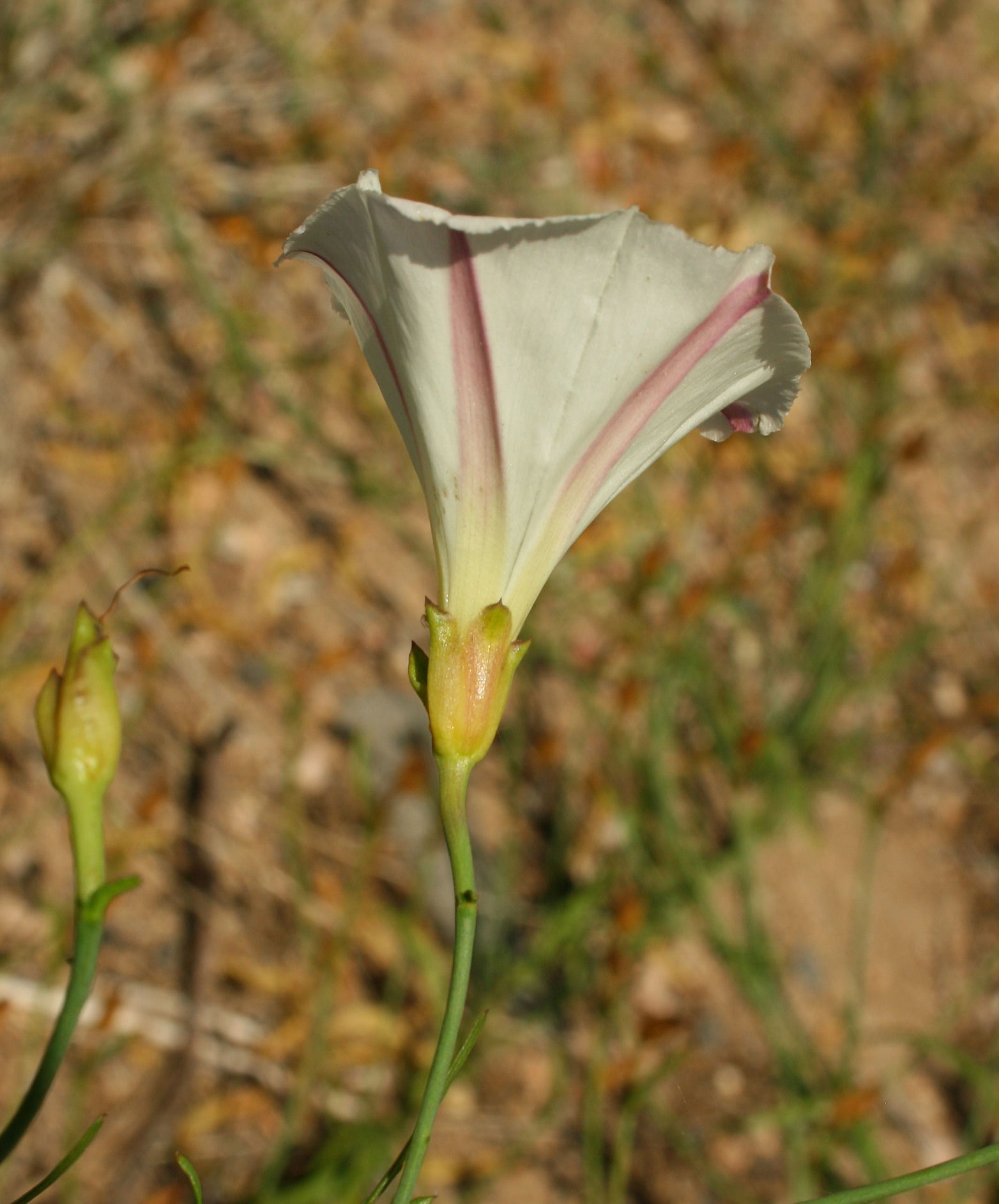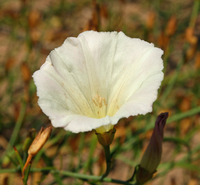Leaves: remote, linear to lanceolate-hastate, 1-8 cm long, the lowermost with well-developed, spreading basal lobes, the lobes 1.3-8 cm long, the upper gradually reduced to linear bracts, the petioles 0.7-3.5 cm long
INFLORESCENCE: 1-few-flowered cymes on slender peduncles, these 5-24 cm long; bracts lanceolate-linear, 0.5-3.5 cm long, near to or remote from the calyx
Flowers: sepals broadly oval, rounded and mucronate at the apex, unequal, the outer shorter, (6-)10-12 mm long; corolla campanulate, white or cream, often with lavender veins, 2.5-3.5 cm long; stamens 18-20 mm long, basally glandular, pubescent on the lower third, the anthers 4 mm long, basally sagittate; ovary ovoid, 2 mm long; style 15-18 mm long
Fruit: FRUITS capsular, 4-valved, surrounded by enlarged sepals and sometimes by bracts, ovoid, tan. SEEDS 1-4, glabrous, dark brown, smooth or reticulate, 3-4 mm long
Misc: Dry slopes, chaparral; 600-1700 m (2000-5600 ft); Mar-Oct
REFERENCES: Austin, Daniel F. 1998. J. Ariz. - Nev. Acad. Sci. Convolvulaceae 30(2): 61.
Duration: Perennial
Nativity: Native
Lifeform: Vine
General: Herbaceous perennial vines, stems trailing or climbing and twining, sometimes woody at the base.
Leaves: Alternate, linear to hastate, 1-8 cm long, 2-6 mm wide, the lowermost with well-developed, spreading basal lobes, the lobes 1-8 cm long, upper lobes gradually reduced to linear bracts, middle lobes linear to lanceolate, blades borne on slender petioles 1-3.5 cm long.
Flowers: Pale pink or white to cream, often with light purple veins, corollas campanulate, 2.5-4 cm long, sepals broadly oval, 6-12 mm long, unequal, (the outer shorter) rounded and mucronate at the tips, calyx 8-10 mm long, bracts lanceolate-linear, 0.5-3.5 cm long, near to or remote from the calyx, stamens 18-20 mm long, basally glandular, pubescent on the lower third, anthers 4 mm long, basally sagittate, flowers borne in 1 to few-flowered cymes on slender peduncles, these 5-24 cm long.
Fruits: Capsules ovoid to oblong, tan, 4-valved, surrounded by enlarged sepals and sometimes by bracts. Seeds dark brown, 3-4 mm long, surfaces glabrous to reticulate, 1-4 per capsule.
Ecology: Found on dry soils, on slopes among oaks and and in chaparral communities, from 2,000-5,500 ft (610-1676 m); flowering March-October.
Distribution: Arizona, California, Nevada, and Utah.
Notes: The pale pink or creamy white flowers and narrow, lanceolate to hastate leaves help to identify this species.
Ethnobotany: Decoction of roots taken for gonorrhea.
Synonyms: Convolvulus longipes, Convolvulus linearilobus
Editor: LCrumbacher 2012
Etymology: Calystegia comes from two Greek words kalux, "cup," and stegos, "a covering," and thus meaning "a covering cup", while longipes means long-stalked.





